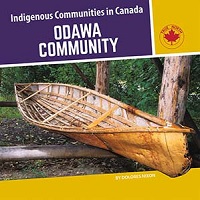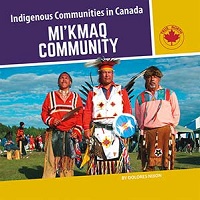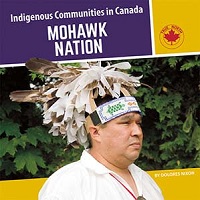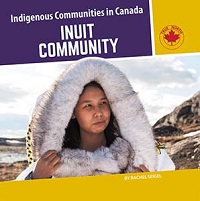| ________________
CM . . . . Volume XXIV Number 18. . . . January 12, 2017
excerpts:
These four books are part of a series now numbering a dozen titles. On each title page, below the author’s name, the publisher identifies the Indigenous content consultant who was associated with that particular title. For instance, Loretta Roy, an elder with the Sheshegwaning First Nation, is identified as the content consultant for Nixon’s Odawa Community while Jeela Palluq-Cloutier, the Executive Director of Inuit Uqausinginnik Taiguusiliuqtiit, served in that role for Seigel’s Inuit Community. Each book in the quartet consists of four chapters that occupy the first 21 pages of these 24 page books. Of these 21 pages, from 4-6 are taken up by full-page colour captioned photos plus a full-page map that locates the geographic areas where the book’s indigenous community can currently be found. Three of the books also contain five photos that can each occupy up to a half page while the fourth, Inuit Community, just has three (but it was the title that included six full-page photos). The point that is being made is that, after you subtract all of the illustration pages, you are left with only some 13 pages of informational text. Now, that is not to say that illustrations, especially captioned ones, cannot also hold information, but they need to be well-chosen. For example, the text of Odawa Community explains that the Odawa lived in wigwaaman and sometimes longhouses. The facing full-page photo shows a “forest” of birch trees, accompanied by the text, “The Odawa used bark from birch trees to build wigwaaman and many everyday items.” In the excerpt above for Mi’kmaq Community, it was also noted that these people lived in birchbark covered wigwams, but, in this instance, that text’s supporting full-page photo was of a wigwam (though its covering really does not look like birchbark). If Dixon did not want to use a wigwam or longhouse photo in Odawa Community, then why not choose a photo of one of the “many everyday items” referred to in the caption? Each book includes several “SAY IT” boxes which provide the pronunciation and English translation of one or more words taken from the language of the book’s peoples. A “SAY IT” in Mohawk Nation includes:
A few pages later, the main text reads:
However, there is no pronunciation offered for the Mohawk word for lacrosse. Most often, in fact, the “SAY IT” boxes’ words have nothing to do with the main text whereas readers, be they child or adult, who encounter Indigenous words in the main text receive no assistance in how to pronounce these words. An “INQUIRY QUESTIONS” box is also part of three of the books, Inuit Community being the exception. That for Mohawk Nation asks: “How do the Mohawk choose their leaders? How is this an effective way to help their people thrive in today’s world?” while Mi’kmaq Community asks, “What rights have the Mi’kmaq fought to keep? Why are these rights important to them?” Given the book’s target audience, these questions are really quite challenging to answer based on the books’ contents alone. A more “answerable” question is asked in Odawa Community : “What items or food did the Odawa create that we still use today?” The books’ final three pages are taken up by three things, with the first being a “GLOSSARY” that contains from 9-13 terms and their definitions. The selected terms had been bolded in the main text. Frankly, I see the inclusion of a glossary to be counterproductive to a child’s fluid reading of a book as I would question how many children actually interrupt their reading to turn to the back of a book for a bolded word’s definition. More effective approaches would be to define the word at the bottom of the page on which it is found or, better, to define it in context. In the “DAILY LIVES” section of Mohawk Nation, Nixon provides an excellent example of the latter: “Women raise corn, beans, and squash. These three foods are the Mohawk’s most important crops. They are known as the three sisters.” The second closing page is labelled “TO LEARN MORE”, and it identifies two or three books and three websites that young readers can consult if they wish “to learn more”. Of the four books, Inuit Community contains, by far, the most age-appropriate books and relevant websites. It is worth noting that one of the cited websites having Inuit content, firstpeoplesofcanada.com, also had content that was very relevant to the other three books, but it was not listed by any of them. Odawa Community references the 400+ page A Concise History of Canada’s First Nations while two of the three books in Mohawk Nation are longer than 160 pages. If the “TO LEARN MORE” offerings are aimed at two different audiences, then it would have been useful to divide them into “Teacher/Parent” and “Child/Student” sections. The websites identified in the other three books varied greatly in their usefulness, with most requiring significant adult intervention if a young student is to identify any content that would be of value to them. The final page consists of an “INDEX” and a brief “ABOUT THE AUTHOR” note. I would question the need for an index in a 24 page book, one with only some 13 pages actually being indexable text. If these last three pages were deemed necessary, by reducing both the font size and the white space, they could have likely been reduced to a single page, thereby opening up space for two more content pages. A blurb on the back cover of each book states:
Perhaps understandable, the books’ contents are weighted significantly more on the “known” past than the “fluid” present, though the books do identify a number of current issues confronting the books’ different communities. Overall, the individual volumes in the “Indigenous Communities in Canada” series are acceptable school purchases, but, content-wise, they still have room for improvement. Recommended. Dave Jenkinson, CM’s editor, lives in Winnipeg, MB.
Next Review |
Table of Contents for This Issue
- January 12, 2018. |



